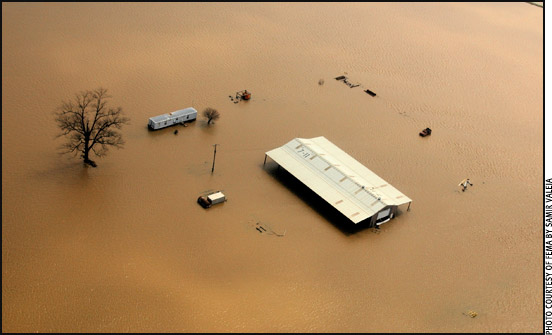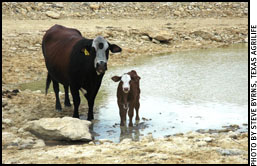HEALTH & NUTRITION...

Anthrax Alert
K-State veterinarian encourages livestock producers to watch for signs of anthrax after flooding.
Flooding along the Missouri and other rivers through the central United States is prompting a call for cattle and other livestock producers to watch for signs of the deadly anthrax bacteria once floodwaters recede.
"Cattle producers in areas along the Missouri River should watch for unexplained cattle deaths which might occur as a result of anthrax spores washing down and being consumed by cattle after the floodwaters recede," said K-State Research and Extension veterinarian Larry Hollis. Veterinarians and animal health officials in North Dakota, Minnesota and Canada have issued similar warnings. Read more.
Summer's Heat Means Watching Cattle for Heat Stress
Cattle producers need to take steps to ward off heat stress in their herds, a University of Nebraska-Lincoln (UNL) beef specialist said.
Late spring 80-degree days with rain are always welcome, but the abundance of moisture in the Central and Northern Plains in late June certainly contributed to elevated relative humidities, which can be disastrous for cattle that have not had a chance to get adapted to hot conditions, said Terry Mader, beef specialist at the UNL's Haskell Agricultural Laboratory near Concord.
Cattle can begin to experience some level of heat stress when the heat index approaches 80° F, with most cattle being severely stressed when the heat index exceeds 100°. Read more.
Water Woes

Drought causing concerns for livestock water availability, quality.
As the drought continues and temperatures remain above normal, cattle water is becoming a greater concern, especially after recent reports of cattle deaths in or around watering points, according to a Texas AgriLife Extension Service specialist.
Ted McCollum, AgriLife Extension beef cattle specialist, said the location of the deceased cattle suggests the deaths could be associated with water consumption.
"Because little or no forage growth has occurred this year, the forage contains very low amounts of water," McCollum said. "An average cow grazing green forage normally consumes about 30 to 70 pounds (lb.) of water daily, or about 3.5 to 8.4 gallons, from the forage she grazes. Read more.

Rick Rasby
Ridin’ Herd
Drought and forage quality
This spring, it seems, has been feast or famine in regard to moisture. There were areas that had lots of moisture and areas that had widespread flooding. Some of the flooding was a result of above-average snowfall in the mountains, and the snowmelt added to the flooding. Then there were areas where there was hardly enough moisture to start any spring grass growth. Trying to feed the whole herd through a drought with purchased feeds can be tough financially, especially if drought conditions are widespread and last for more than one growing season. Forage seems to be different in quality when grown in drought conditions compared to more normal conditions. Read more.
Drought Can Force Livestock
to Eat Poisonous Plants
The relentless drought that has settled over much of Kansas and states across the south brings more problems than the lack of pasture forage growth for livestock producers.
One potential problem, according to K-State Research and Extension Veterinarian Larry Hollis, is that weedy species with greater drought tolerance sometimes outcompete desirable grasses and begin to proliferate. Another scenario is that desirable forage species are consumed but fail to regrow, and only weedy species are left in a green vegetative state.
"Either of these scenarios can become a major problem if these remaining plants also contain toxic components," Hollis said. "Fortunately, many toxic plants are also unpalatable, so livestock species tend to leave those plants alone. However, the problem comes when pastures are not properly managed, or forage supplementation is not provided in a timely fashion, and livestock are left with no choice but to consume toxic plants or go hungry.
"Good pasture and livestock management call for knowing the toxic plant species that are common in your area or pastures," he said. "It's also important to recognize when pastures are getting short enough that cattle may be forced to consider undesirable options, and either supplement the cattle with hay or other feedstuffs or move them to drylot situations or different pastures where available forages do not pose a toxicity threat to them. Cattle will eat toxic plants if starved."
Unloading Mycoplasma bovis
The next load of cattle may carry more than just an opportunity for profit.
Producers who regularly deal with high-risk cattle — those animals that may weigh a little less or that have been commingled with others from different backgrounds — have seen what Mycoplasma bovis can do to cattle health. However, even the best-prepared operations can experience the disease.
"If you are buying well-managed cattle, you don't generally see M. bovis as a common theme, but every once in a while you get proof of the problem," says veterinarian Daniel Scruggs, Veterinary Operations, Pfizer Animal Health. "We don't know how it happens, but all of a sudden we can see herds that are treating for M. bovis, but by far the most common manifestation is in cattle that are at high risk." Read more.
Preconditioning:
A Win for Buyers and Sellers
Calf preconditioning benefits extend beyond sale day.
It's well-documented that calf preconditioning programs can help cow-calf producers boost their profitability on sale day — even to the tune of an extra $6.38 per hundredweight (cwt.). Adding icing to the cake, calf preconditioning also has been shown to positively affect feeder calf performance."Preconditioning sets calves up to be more successful in the feedlot, which means the benefits stretch beyond a bigger check for the cow-calf producer," says Gerald Stokka, veterinarian with Pfizer Animal Health. "Successful preconditioning helps promote calf growth, enhances immune function and helps minimize stress, all of which lead to higher performance and profitability." Read more.
Consider Cover Crops for Unplanted Acres
Planting conditions from a wet spring left some Minnesota fields unplanted. Emerging crops in some areas have been hit with wind, hail and ponded water. Farmers have been left with three choices: plant a crop that may not fully mature, use tillage or herbicides to limit weeds, or plant a cover crop.
Cover crops are ideal for prevented plant acres. Cover crops also work well after small grains, canning crops and silage. They can even be worked into the corn-soybean rotation, especially when overseeded at the leaf yellowing stage. A cover crop is any crop grown between two cash crops. Read more.
Cattle Diseases: Common Conditions/Terms
Click here for a list of common conditions and terms related to beef cattle diseases, such as anaplasmosis, brucellosis, BVD, E. coli, IBR and others.
[Click here to go to the top of the page.]













